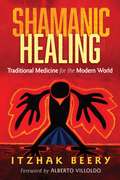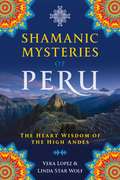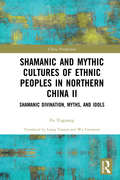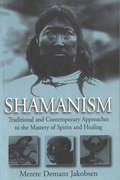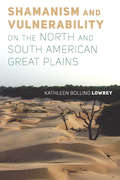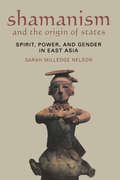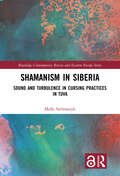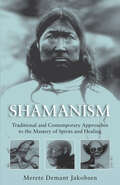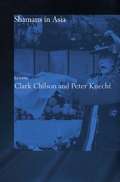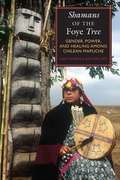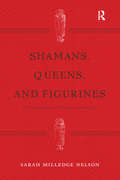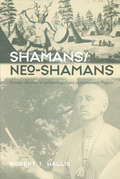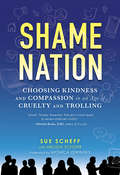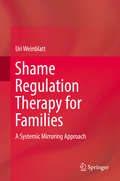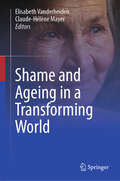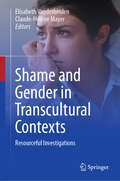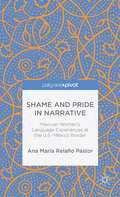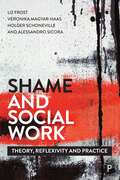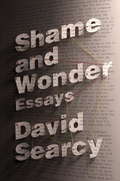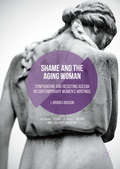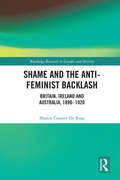- Table View
- List View
Shamanic Healing: Traditional Medicine for the Modern World
by Alberto Villoldo Itzhak BeeryA story-based guide to the techniques of shamanic healing• Details indigenous medicine tools and soul healing techniques, including diagnosis and energy cleansing with plants, stones, fire, flower essences, and sound• Offers protection and self-defense techniques for confronting negative energies such as spirit attachment and possession• Shares healing stories that each address a specific condition, such as panic attacks, PTSD, depression, cancer, chronic pain, grief, and relationship problemsShamanic healing is making an astonishing comeback all over the modern technology-driven and consumerist world. Millions of people have felt called to integrate both ancient and modern healing systems into a new model of healthcare. But what makes shamanic healing so powerful? Why have indigenous healers kept it alive for thousands of years?Revealing his personal journey and stories from his more than 20 years as a shamanic healer, Itzhak Beery explains who a shaman is and how he or she works, demystifying and destigmatizing the shamanic healing worldview. He shares shamanic wisdom from two of his teachers: a Yachak from Ecuador and a well-known Brazilian Pagé. He details indigenous medicine tools and soul healing techniques that you can practice with your own clients or in your own personal healing, including diagnosis and energy cleansing with plants, stones, fire, rum, eggs, flower essences, and sound. He shares protection and self-defense techniques for confronting negative energies, such as spirit attachment and possession. Sharing healing stories that each address a specific condition, such as panic attacks, PTSD, depression, cancer, chronic pain, grief, and relationship problems, Beery explains how a shaman is not responsible for curing everyone and will consult with the patient’s soul to determine its needs, which sometimes includes learning from the illness experience.By sharing these healing methods, Beery reveals the importance of shamanic practices in resolving our 21st-century emotional and physical problems and their importance to the future of humanity and the planet.
Shamanic Mysteries of Peru: The Heart Wisdom of the High Andes
by Vera Lopez Linda Star WolfAn experiential guide to the sacred places and teachings of Andean shamanism • Explores the cosmology and core shamanic beliefs of the Andean people, including Pachamama and power animals such as condors, snakes, hummingbirds, and pumas • Takes you on an intimate journey through the sacred sites, temples, and power places of Peru, including Machu Picchu, Cuzco, Ollantaytambo, Sacsayhuamán, Písac, Lake Titicaca, and more • Shares initiatory rites and shamanic journeying practices to allow you to integrate and embody the wisdom of each sacred place The Andes Mountains of Peru are rich with ancient shamanic traditions, sacred places, and heart wisdom passed down from the Inca and safeguarded for generations by the Q&’eros nation. In this experiential guide to the wisdom and practices of the Andean people and their sacred land, Vera Lopez and Linda Star Wolf take you on an intimate journey through the sacred sites, temples, and power places of Peru, including Machu Picchu, Cuzco, Ollantaytambo, Sacsayhuamán, Písac, Lake Titicaca, and more. They show how each of these powerful sites holds an ancient wisdom--an initiation left behind by the Inca--and they share initiatory rites and shamanic journeying practices to allow you to integrate and embody the wisdom of each sacred place. The authors explore the cosmology and core shamanic beliefs of the Andean people, including Pachamama, the Sacred Law of Reciprocity, the Serpent of Light, the Chakannah, and power animals such as condors, snakes, hummingbirds, and pumas. They examine healing practices and sacred plants of this tradition, including a look at the shamanic use of ayahuasca and San Pedro. Offering direct access to the gentle heart of wisdom found within the ancient shamanic land of Peru, the authors show how the Andean shamanic tradition offers an antidote to the modern epidemic of Soul Loss by connecting us back to our authentic self and the universal principles of love, reciprocity, and gratitude.
Shamanic Transformations: True Stories of the Moment of Awakening
by Itzhak BeeryInspiring accounts from renowned contemporary working shamans about their first moments of spiritual epiphany • With contributions by Sandra Ingerman, Hank Wesselman, John Perkins, Alberto Villoldo, Lewis Mehl-Madrona, Tom Cowan, Lynn Andrews, Linda Star Wolf, and others • Also includes shamanic awakening experiences from those with unique shamanic paths--teachers, mothers, social workers, academics, and even rappers How does one receive the “call” to enter onto the shamanic path? What causes some people to change their safe, uneventful, and ordinary lives and start on a spiritual search? For many it is a singular instant, a flash when the mystical reveals itself and the person is drawn into the world of shamanic power. For a few, it is a more gradual awakening, filled with numinous events that build upon one another until the calling of the shamanic path can no longer be ignored. In this book of remarkable stories, we learn firsthand about the many different forms of the “aha” moment of shamanic awakening, whether they arise from ceremony, near-death experiences, dream messages, or entheogenic substances. We travel alongside Sandra Ingerman, Hank Wesselman, John Perkins, Alberto Villoldo, Lewis Mehl-Madrona, Tom Cowan, Lynn Andrews, Linda Star Wolf, and other well-known shamanic practitioners as they begin their transformations into the prominent shamans we know them as. We experience the real-life shamanic epiphanies of those with unique shamanic paths--teachers, mothers, social workers, academics, healers, and even rappers who have all experienced a moment in time in which they were awakened and the shamanic path showed itself to them. As each of these unique and beautiful stories of unexpected realization, insight, and inspiration unfolds, we see how these single moments--usually entirely unexpected--are able to transform the individual’s life, clearing their vision and allowing a new consciousness to emerge. As a whole, this collection paints a breathtaking portrait of the intricacies of the shamanic path and the paradigm shift of which we all are part.
Shamanic and Mythic Cultures of Ethnic Peoples in Northern China I: Shamanic Deities and Rituals (China Perspectives)
by Fu YuguangOn the basis of first-hand materials gathered through decades of field research and fleshed out with the author’s insightful religious, cultural, and historical observations extending back to the Qing dynasty, ancient archaeological discoveries, and the legacy of Siberian peoples, this two-volume ethnological study investigates shamanic rituals, myths, and lore in northern China and explores the common ideology underlying the origins of the region’s cultures. Drawing from numerous oral myths, ancient documents, and archaeological findings, this first volume discusses the spiritual world of northern shamanism and investigates the various rituals, including ancestor worship, fertility, nature deities, blood sacrifice and rites, the worshiping of nature, and shrines. The book illuminates how these rituals and worships, animism, and ideas of the soul are imbedded in and interweave with the indigenous environment, culture, and history of the clans and people of northern China. The book will be of great value to scholars of religion and to both anthropologists and ethnologists in the fields of shamanism studies, Northeast Asian folklore, and Manchu studies.
Shamanic and Mythic Cultures of Ethnic Peoples in Northern China II: Shamanic Divination, Myths, and Idols (China Perspectives)
by Fu YuguangOn the basis of first-hand materials gathered through decades of field research and fleshed out with the author’s insightful religious, cultural, and historical observations extending back to the Qing dynasty, ancient archaeological discoveries, and the legacy of Siberian peoples, this two-volume ethnological study investigates shamanic rituals, myths, and lore in northern China and explores the common ideology underlying the origins of the region’s cultures. This second volume focuses on northern shamanic divination, spirit idols, and folklore covering the myths of the Manchu-Tungus, Manchu creation shrine tales, and individual tribal myths. This mythic heritage helps identify shared patterns of thought among the ethnic peoples of northern China; points to cultural integration with Buddhist, Daoist, and Han Chinese cultures; and shows their understand of the natural world, the creation of humankind, social life, and history and their interactions with their surroundings. In this regard, shamanic spirituality in northern China is characterized by functionality and practicality in daily life situations, in contrast to the received wisdom that defines shamanic praxis as a pure supernatural spirit journey. The book will be of great value to scholars of religion and to both anthropologists and ethnologists in the fields of shamanism studies, Northeast Asian folklore, and Manchu studies.
Shamanism
by Merete Demant JakobsenShamanism has always been of great interest to anthropologists. More recently it has been "discovered" by westerners, especially New Age followers. This book breaks new ground byexamining pristine shamanism in Greenland, among people contacted late by Western missionaries and settlers. On the basis of material only available in Danish, and presented herein English for the first time, the author questions Mircea Eliade's well-known definition of the shaman as the master of ecstasy and suggests that his role has to be seen as that of a master of spirits. The ambivalent nature of the shaman and the spirit world in the tough Arctic environment is then contrasted with the more benign attitude to shamanism in the New Age movement. After presenting descriptions of their organizations and accounts by participants, the author critically analyses the role of neo-shamanic courses and concludes that it is doubtful to consider what isoffered as shamanism.
Shamanism and Vulnerability on the North and South American Great Plains
by Kathleen Bolling LowreyIn Shamanism and Vulnerability on the North and South American Great Plains Kathleen Bolling Lowrey provides an innovative and expansive study of indigenous shamanism and the ways in which it has been misinterpreted and dismissed by white settlers, NGO workers, policymakers, government administrators, and historians and anthropologists. Employing a wide range of theory on masculinity, disability, dependence, domesticity, and popular children’s literature, Lowrey examines the parallels between the cultures and societies of the South American Gran Chaco and those of the North American Great Plains and outlines the kinds of relations that invite suspicion and scrutiny in divergent contexts in the Americas: power and autonomy in the case of Amerindian societies and weakness and dependence in the case of settler societies. She also demonstrates that, where stigmatized or repressed in practice, dependence and power manifest and intersect in unexpected ways in storytelling, fantasy, and myth. The book reveals the various ways in which anthropologists, historians, folklorists, and other writers have often misrepresented indigenous shamanism and revitalization movements by unconsciously projecting ideologies and assumptions derived from modern ‘contract societies’ onto ethnographic and historical realities. Lowrey also provides alternative ways of understanding indigenous American communities and their long histories of interethnic relations with expanding colonial and national states in the Americas. A creative historical and ethnographical reevaluation of the last few decades of scholarship on shamanism, disability, and dependence, Shamanism and Vulnerability on the North and South American Great Plains will be of interest to scholars of North and South American anthropology, indigenous history, American studies, and feminism.
Shamanism and the Origin of States: Spirit, Power, and Gender in East Asia
by Sarah Milledge NelsonSarah Milledge Nelson’s bold thesis is that the development of states in East Asia—China, Japan, Korea—was an outgrowth of the leadership in smaller communities guided by shamans. Using a mixture of historical documents, mythology, archaeological data, and ethnographic studies of contemporary shamans, she builds a case for shamans being the driving force behind the blossoming of complex societies. More interesting, shamans in East Asia are generally women, who used their access to the spirit world to take leadership roles. This work challenges traditional interpretations growth of Asian states, which is overlaid with later Confucian notions of gender roles. Written at a level accessible for undergraduates, this concise work will be fascinating reading for those interested in East Asian archaeology, politics, and society; in gender roles, and in shamanism.
Shamanism in Siberia: Sound and Turbulence in Cursing Practices in Tuva (Routledge Contemporary Russia and Eastern Europe Series)
by Mally StelmaszykThe focus of this book is on the phenomenon of cursing in shamanic practice and everyday life in Tuva, a former Soviet republic in Siberia. Based on extensive anthropological fieldwork where the author interacted with a wide range of people involved in cursing practices, the book examines Tuvans’ lived experience of cursing and shamanism, thereby providing deep insights into Tuvans’ intimate and social worlds. It highlights especially the centrality of sound: how interactions between humans and non-humans are brought about through an array of sonic phenomena, such as musical sounds, sounds within words and non-linguistic vocalisations, and how such sonic phenomena are a key part of dramatic cursing events and wider shamanic performance and ritual, involving humans and spirits alike. Overall, the book reveals a great deal about occult practices and about social change in post-Soviet Tuva.
Shamanism: Traditional and Contemporary Approaches to the Mastery of Spirits and Healing
by Merete Demant JakobsenShamanism has always been of great interest to anthropologists. More recently it has been "discovered" by westerners, especially New Age followers. This book breaks new ground byexamining pristine shamanism in Greenland, among people contacted late by Western missionaries and settlers. On the basis of material only available in Danish, and presented herein English for the first time, the author questions Mircea Eliade's well-known definition of the shaman as the master of ecstasy and suggests that his role has to be seen as that of a master of spirits. The ambivalent nature of the shaman and the spirit world in the tough Arctic environment is then contrasted with the more benign attitude to shamanism in the New Age movement. After presenting descriptions of their organizations and accounts by participants, the author critically analyses the role of neo-shamanic courses and concludes that it is doubtful to consider what isoffered as shamanism.
Shamans and Robots: On Ritual, the Placebo Effect, and Artificial Consciousness (Univocal)
by Roger BartraA profound exploration of the external influences that shape human consciousness, from healing rituals to digital devices In this voyage through thousands of years of psychosomatic healing, distinguished anthropologist and sociologist Roger Bartra examines the placebo effect as a key to our understanding of human consciousness. Shamans and Robots demonstrates how biology and technology become intertwined within human culture by using the various histories of ritual and symbolic healing to speculate about future developments in artificial intelligence. Charting the extensive history of the placebo effect through medieval healing, shamanism, and early psychoanalytic practices, Bartra posits that consciousness is not simply the province of the mind but something equally shaped by external systems and objects. He finds evidence of this &“exocerebrum&”—the extension of our brains outside the body—in the shamanistic concept of the placebo, in which external objects heal our bodies, and in modern technical devices like prostheses or robots, whose development of a mechanical consciousness would have to mimic, and in turn elucidate, the processes involved in the creation of consciousness in humans. Through this radical concept, he analyzes digital media&’s relationship to the functions of the human brain and probes the possibility of artificial consciousness. Both a look at the human body&’s potential to restore itself and a profound reflection on the curative power of symbolic structures, Shamans and Robots explores how our technologies increasingly serve as extensions of our cognitive selves.
Shamans in Asia
by Clark Chilson Peter KnechtShamans throughout much of Asia are regarded as having the power to control and coerce spirits. Many Asians today still turn to shamans to communicate with the world of the dead, heal the sick, and explain enigmatic events. To understand Asian religions, therefore, a knowledge of shamanism is essential. Shamans in Asia provides an introduction to the study of shamans and six ethnographic studies, each of which describes and analyses the lives and activities of shamans in five different regions: Siberia, China, Korea, and the Ryukyu islands of southern Japan, Bangladesh and Pakistan. The essays show what type of people become shamans, what social roles they play, and how shamans actively draw from the worldviews of the communities in which they operate. As the first book in English to provide in-depth accounts of shamans from different regions of Asia, it allows students and scholars to view the diversity and similarities of shamans and their religions. Those interested in spiritual specialists, the anthropological study of religion, and local religions in Asia will be intrigued, if not entranced, by Shamans in Asia.
Shamans of the Foye Tree
by Ana Mariella BacigalupoDrawing on anthropologist Ana Mariella Bacigalupo's fifteen years of field research, Shamans of the Foye Tree: Gender, Power, and Healing among Chilean Mapuche is the first study to follow shamans' gender identities and performance in a variety of ritual, social, sexual, and political contexts. To Mapuche shamans, or machi, the foye tree is of special importance, not only for its medicinal qualities but also because of its hermaphroditic flowers, which reflect the gender-shifting components of machi healing practices. Framed by the cultural constructions of gender and identity, Bacigalupo's fascinating findings span the ways in which the Chilean state stigmatizes the machi as witches and sexual deviants; how shamans use paradoxical discourses about gender to legitimatize themselves as healers and, at the same time, as modern men and women; the tree's political use as a symbol of resistance to national ideologies; and other components of these rich traditions. The first comprehensive study on Mapuche shamans' gendered practices, Shamans of the Foye Tree offers new perspectives on this crucial intersection of spiritual, social, and political power.
Shamans, Queens, and Figurines: The Development of Gender Archaeology
by Sarah Milledge NelsonSarah Nelson, recognized as one of the key figures in studying gender in the ancient world and women in archaeology, brings together much of the work she has done over three decades into a single volume. The book covers her theoretical contributions, her extensive studies of gender in the archaeology of East Asia, and her literary work on the subject. Included with the selections of her writing-- taken from diverse articles and books published in a variety of places-- is an illuminating commentary about the development of her professional and personal understanding of how gender plays out in ancient societies and modern universities and her current thinking on both topics.
Shamans/Neo-Shamans: Ecstasies, Alternative Archaeologies and Contemporary Pagans
by Robert J. WallisIn popular culture, such diverse characters as occultist Aleister Crowley, Doors musician Jim Morrison, and performance artist Joseph Beuys have been called shamans. In anthropology, on the other hand, shamanism has associations with sorcery, witchcraft and healing, and archaeologists have suggested the meaning of prehistoric cave art lies with shamans and altered consciousness. Robert J. Wallis explores the interface between 'new' and prehistoric shamans. The book draws on interviews with a variety of practitioners, particularly contemporary pagans in Britain and north America. Wallis looks at historical and archaeological sources to explore contemporary pagan engagements with prehistoric sacred sites such as Stonehenge and Avebury, and discusses the controversial use by neo-Shamans of indigenous (particularly native American) shamanism.
Shame Nation: The Global Epidemic Of Online Hate
by Melissa Schorr Sue Scheff Monica Lewinksy"Engaging, sharp, and important — Shame Nation will inspire you to open your eyes and be better." — Theresa Payton, CEO of Fortalice Solutions and Deputy Director of Intelligence on CBS' HuntedIn today's digitally driven world, disaster is only a click away. A rogue tweet could bring down a business; an army of trolls can run a celebrity off-line; and virtual harassment might cause real psychological damage. Shame Nation is the first book to both study the fascinating phenomenon of online shaming, and offer practical guidance and inspiring advice on how to prevent and protect against cyber blunders and faceless bullies. Author and acclaimed Internet safety expert Sue Scheff unveils all sides of an issue that it only becoming more relevant day by day while drawing from the expertise of other top professionals spanning fields including law, psychology, and reputation management.From damning screenshots to revenge porn, Shame Nation shines a light on the rising trend of an online shame culture and empowers readers to take charge of their digital lives.
Shame Regulation Therapy for Families: A Systemic Mirroring Approach
by Uri WeinblattThis accessible guide introduces systemic mirroring, an innovative approach to understanding and managing the disruptive presence of shame in family therapy. Shame is analyzed in individual and interpersonal contexts, and in two basic problematic states—experiencing too much or too little shame—often found at the root of serious problems between children and their parents. The author offers potent conversation-based strategies for working with children, adolescents, and their families, and for working with parents to resolve their own shame issues so they can improve their relationships with their children. The author also illustrates how shame regulation can improve the bond between client and therapist and produce lasting effects as clients learn to disengage from shame. This practical resource: Offers an innovative approach to dealing with shame in therapy Integrates practical methods for use with children, adolescents, and parents Discusses how shame derails interpersonal communication Provides interventions for shame management and dealing with the state of shamelessness Shows how parents can regulate their own shame at the couple level Applies these methods to school settings Shame Regulation Therapy for Families aides the work of professionals such as psychologists, psychiatrists, social workers, and school psychologists who work with children and their families on shame management.
Shame and Ageing in a Transforming World
by Elisabeth Vanderheiden Claude-Hélène MayerThe book provides a comprehensive overview of research and concepts related to shame and ageing, in the context of social change, upheavals and paradigm shifts, from transdisciplinary, cultural and transcultural perspectives. Drawing upon the editors' previous works on the topic of shame, this volume discusses the contexts of shame and ageing from theoretical, conceptual, and empirical perspectives. The toxic and stressful aspects of shame have been the focus of scientific analysis and discourse on shame and ageing. This volume explicitly makes the dimensions of shame a resource for individuals, and collective transformation processes the object of research in the context of ageing. It looks at emerging lifestyle, political, socio-economic and health contexts. It looks at how and why the frequency, intensity and handling of feelings of shame change over the course of life; the impact of shame on emotional well-being and mental health of older people; the impact of shame on social relationships and social engagement of older people in different cultures; the role of cultural values and norms in the development and processing of feelings of shame, especially in older people, and how these can be used for self-development; and the differences in the way older people in different cultures deal with feelings of shame and the way these can be used to develop effective strategies and techniques for older people to cope with shame. The editors and contributors thereby take cultural and gender aspects, as well as positive psychology and resource-orientated concepts, such as salutogenesis, resilience, happiness, fortitude, locus of control, faith- or strengths-based approaches into account and contextualize them against processes of social upheaval and transformation.
Shame and Gender in Transcultural Contexts: Resourceful Investigations
by Elisabeth Vanderheiden Claude-Hélène MayerThis volume is envisioned as a primary reference in research, studies and concepts on shame through the lens of gender and from transdisciplinary, cultural and transcultural perspectives. It sheds light on the state of the art regarding shame and its meaning in the context of gender from theoretical, conceptual, and empirical perspectives from the standpoint of positive psychology. Since the experience of shame, the expression of shame as well as the individual or collective handling of shame depends in a special way on cultural factors, special importance has been given in the chapters to the consideration of cultural framework conditions. This volume is founded on the editors' first three publications on shame from positive psychology perspectives and an upcoming work on shame and ageing.
Shame and Honor
by Stephanie Trigg"It's a nice piece of pageantry. . . . Rationally it's lunatic, but in practice, everyone enjoys it, I think."--HRH Prince Philip, Duke of EdinburghFounded by Edward III in 1348, the Most Noble Order of the Garter is the highest chivalric honor among the gifts of the Queen of England and an institution that looks proudly back to its medieval origins. But what does the annual Garter procession of modern princes and politicians decked out in velvets and silks have to do with fourteenth-century institutions? And did the Order, in any event, actually originate in the wardrobe malfunction of the traditional story, when Edward held up his mistress's dropped garter for all to see and declared it to be a mark of honor rather than shame? Or is this tale of the Order's beginning nothing more than a vulgar myth?With steady erudition and not infrequent irreverence, Stephanie Trigg ranges from medieval romance to Victorian caricature, from imperial politics to medievalism in contemporary culture, to write a strikingly original cultural history of the Order of the Garter. She explores the Order's attempts to reform and modernize itself, even as it holds onto an ambivalent relationship to its medieval past. She revisits those moments in British history when the Garter has taken on new or increased importance and explores a long tradition of amusement and embarrassment over its formal processions and elaborate costumes. Revisiting the myth of the dropped garter itself, she asks what it can tell us about our desire to seek the hidden sexual history behind so venerable an institution.Grounded in archival detail and combining historical method with reception and cultural studies, Shame and Honor untangles 650 years of fact, fiction, ritual, and reinvention.
Shame and Pride in Narrative: Mexican Women’s Language Experiences at the U.S.–Mexico Border
by Ana María Relaño PastorThis book analyzes personal experiences of language through the voices of Mexican immigrant women, in relation to the racialization discourses that frame the social life of Mexican immigrant communities in the United States. It reveals the power of narrative, understood as a social practice, to validate and give meaning to people's lives.
Shame and Social Work: Theory, Reflexivity and Practice
by Liz Frost, Veronika Magyar-Haas, Holger Schoneville and Alessandro SicoraFor many service users and professionals in the field of social work, shame is an ongoing part of their daily experience. Providing an in-depth examination of the complex phenomena of shame and humiliation, this book sets out key contextual issues and theoretical approaches to comprehend shame and its relevance within social work. It provides a broad understanding of shame, its underlying social and political contexts and its effects on service users and professionals. The book uses innovative international scholarship and includes theoretical considerations, as well as empirical findings within the field of social work. It shows the importance of sensitive, reflective and relationship-oriented practice based on a better understanding of the complexity of shame.
Shame and Wonder
by David SearcyFor fans of John Jeremiah Sullivan, Leslie Jamison, Geoff Dyer, and W. G. Sebald, the twenty-one essays in David Searcy's debut collection are captivating, daring--and completely unlike anything else you've read before. Forging connections between the sublime and the mundane, this is a work of true grace, wisdom, and joy.Expansive in scope but deeply personal in perspective, the pieces in Shame and Wonder are born of a vast, abiding curiosity, one that has led David Searcy into some strange and beautiful territory, where old Uncle Scrooge comic books reveal profound truths, and the vastness of space becomes an expression of pure love. Whether ruminating on an old El Camino pickup truck, those magical prizes lurking in the cereal boxes of our youth, or a lurid online ad for "Sexy Girls Near Dallas," Searcy brings his unique blend of affection and suspicion to the everyday wonders that surround and seduce us. In "Nameless," he ruminates on spirituality and the fate of an unknown tightrope walker who falls to his death in Texas in the 1880s, buried as a local legend but without a given name. "The Hudson River School" weaves together Google Maps, classical art, and dental hygiene into a story that explores--with exquisite humor and grace--the seemingly impossible angles at which our lives often intersect. And in "An Enchanted Tree Near Fredericksburg," countless lovers carve countless hearts into the gnarled trunk of an ancient oak tree, leaving their marks to be healed, lifted upward, and, finally, absorbed. Haunting, hilarious, and full of longing, Shame and Wonder announces the arrival of David Searcy as an essential and surprising new voice in American writing. Advance praise for Shame and Wonder"Shame and Wonder is a work of genius--a particular kind of genius, to be sure, one that bides more comfortably with questions, potentialities, mysteries, and wonders than with the hard-and-fast answers that the information age has taught us to crave. If you want to know things, real things, read Shame and Wonder. It will knock you flat and lift you up."--Ben Fountain, author of Billy Lynn's Long Halftime Walk "Reading David Searcy isn't like reading anyone else. His voice is weird and it's smart and it's right here, oddly close, paying attention to cereal prizes and possums, to the loneliness of new bedrooms and the slow fade of hearts etched into bark. Searcy probes moments that pulse with secret electricity."--Leslie Jamison, author of The Empathy Exams "Searcy reminds us what voice means and why it's useful. We can hear something here, something achieved and distinctive. A writer has figured out how to bring the style of his prose into near-perfect alignment with his habit of mind, and to trust the impulses of his curiosity in such a way that we seem to experience not effort but flowing thought."--John Jeremiah Sullivan, author of Pulphead "Strange, wonderful, and full of curiosity and nostalgia, David Searcy's essays chip away at the world around us to lay bare the beauty and sadness at the heart of it all."--Gay Talese"The essays in this debut collection . . . suggest what might happen if Stephen King somehow morphed into David Foster Wallace. . . . Meaning and mystery coexist in Searcy's mind, and his offbeat, exciting writing will resonate."--Kirkus Reviews (starred review) "Offbeat, beguiling . . . Searcy's writing is by sharp turns goofy, wry, and melancholy, [and] always curious and superbly evocative."--Publishers Weekly (starred review)From the Hardcover edition.
Shame and the Aging Woman
by J. Brooks BousonThis book brings together the research findings of contemporary feminist age studies scholars, shame theorists, and feminist gerontologists in order to unfurl the affective dynamics of gendered ageism. In her analysis of what she calls "embodied shame," J. Brooks Bouson describes older women's shame about the visible signs of aging and the health and appearance of their bodies as they undergo the normal processes of bodily aging. Examining both fictional and nonfiction works by contemporary North American and British women authors, this book offers a sustained analysis of the various ways that ageism devalues and damages the identities of otherwise psychologically healthy women in our graying culture. Shame theory, as Bouson shows, astutely explains why gendered ageism is so deeply entrenched in our culture and why even aging feminists may succumb to this distressing, but sometimes hidden, cultural affliction.
Shame and the Anti-Feminist Backlash: Britain, Ireland and Australia, 1890-1920 (Routledge Research in Gender and History #29)
by Sharon Crozier-De RosaShame and the Anti-Feminist Backlash examines how women opposed to the feminist campaign for the vote in early twentieth-century Britain, Ireland, and Australia used shame as a political tool. It demonstrates just how proficient women were in employing a diverse vocabulary of emotions – drawing on concepts like embarrassment, humiliation, honour, courage, and chivalry – in the attempt to achieve their political goals. It looks at how far nationalist contexts informed each gendered emotional community at a time when British imperial networks were under extreme duress. The book presents a unique history of gender and shame which demonstrates just how versatile and ever-present this social emotion was in the feminist politics of the British Empire in the early decades of the twentieth century. It employs a fascinating new thematic lens to histories of anti-feminist/feminist entanglements by tracing national and transnational uses of emotions by women to police their own political communities. It also challenges the common notion that shame had little place in a modernizing world by revealing how far groups of patriotic womanhood, globally, deployed shame to combat the effects of feminist activism.
